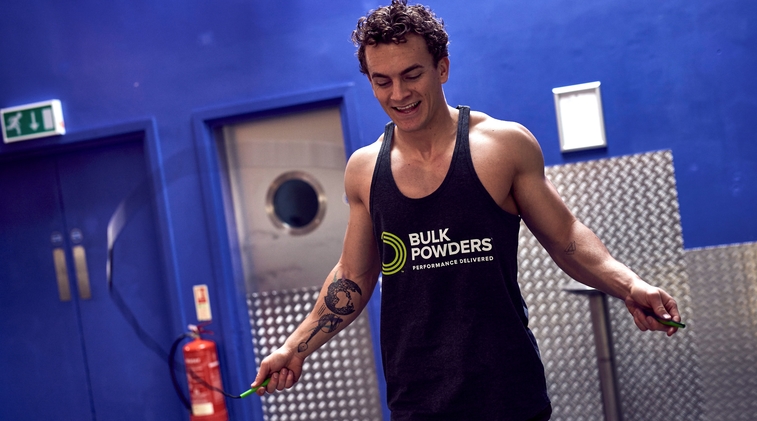Summer has very much arrived! The sun is beaming, the beaches are packed, the shirts are off and the abs are out… or not? Introducing your new best friend, Metabolic Conditioning.
Metabolic conditioning is a method of training, ideal for those who are time restricted in training and also those who love a high intensity workout – make no mistake, this is no steady state training.
Metabolic conditioning is not as complex as it sounds… it’s simply structured periods of training and rest to induce a desired response from the body. “Metabolic” refers to the consumption of energy, and this is categorised into three sections:
Aerobic (think endurance)
Glycolytic (someone who has to combine endurance with power, like a boxer).
ATP-PC System (imagine a 10-15 second athlete who performs at extremely high intensity, such as BULK POWDERS® Athlete & Sprinter Rebecca Campsall)
How we structure our metabolic conditioning sessions depends on what the desired outcome is – do we want to develop better Aerobic capacity or look like an endurance runner? Or do we want to build lean muscle and burn as much fat as possible? How we answer these questions should define the metabolic conditioning workouts we create and perform.
Example Structures of Metabolic Conditioning
Aerobic Development Example
5 minutes work – 1 minute rest – 3 rounds.
1 minute Air Squats
1 minute Sit Ups
1 minute Kettlebell Swings
1 minute Plank
1 minute Skipping
This style of workout will develop the aerobic system, incorporating a low % of rest/training. This is ideal for those who don’t have the time for a 10k run but want to increase their training patterns in the lead up to competition.
Power Output Development
10 seconds work – 1.5 minutes rest – 5 rounds.
Heavy Kettlebell Swings
Weighted Jumping Lunges
Resistance Band Sprints
Jumping Squats
This style of workout needs to be explosive (e.g. kettlebell swings performed as powerfully as possible), it targets the fast twitch fibres to exhaustion in a short period of time, by limiting the training time, we reduce wastage of energy on pathways that are less relevant to the desired outcome.
Lean Muscle Development
45 seconds work – 15 seconds rest – 3 rounds.
Resistance Band Runs
Bent Over Rows
Push Press
Hanging Leg Raises
Goblet Squats
The type of training will cross into various energy pathways, the aerobic element will help elicit the usage of fatty acids as an energy source, whilst the moderate intensity will enable enough muscle fibre damage to promote growth in the repair process – hence the lean muscle development!
Why should you try this?
According to the journal of Strength and Conditioning, there are numerous benefits to Metabolic Conditioning.
- On completion of a “Metcon”, the bodies metabolic cycle is elevated for hours post workout, this means the body is still burning calories and using excess energy sources.
- This style of training can be tweaked according to what your body/sporting goals are, whether you want to be big, strong, lean or an athlete!
- Whatever your goals, you can accomplish them, and it doesn’t have to take hours.
- When you get fitter, you do more reps – it’s easy to track and you don’t need to worry about re-writing programmes every four weeks.
- No equipment? No problem! Get into the garden; Burpees, Squats, Lunges, Sit Ups, Press Ups, Sprints, the list is endless.
References
Bartholmew, SA. Plyometric and vertical jump training. Master’s thesis, University of North Carolina, Chapel Hill, 1985.
Kvorning, Thue; Hansen, Mikkel R.B.; Jensen, Kurt Journal of Strength & Conditioning Research . 31(7):1759-1765, July 2017.
Kipp, Kristof; Harris, Chad Journal of Strength & Conditioning Research. 31(7):1905-1910, July 2017.
Kipp, Kristof; Harris, Chad Journal of Strength & Conditioning Research. 31(7):1905-1910, July 2017
Allen TE, Byrd RJ, Smith DP. Hemodynamic Consequences of Circuit Weight Training. Research Quarterly. American Alliance for Health, Physical Education and Recreation 1976;47(3):299-306. Available from: http://www.nlm.nih.gov/medlineplus/exerciseandphysicalfitness.html PubMed PMID: 1069316
Bloomer RJ. Energy cost of moderate-duration resistance and aerobic exercise. Journal of strength and conditioning research. National Strength & Conditioning Association 2005;19(4):878-882. Available from: http://www.scholaruniverse.com/ncbi-linkout?id=16287370 PubMed PMID: 16287370. doi: 10.1519/R-16534.1.
Helgerud J. Aerobic high-intensity intervals improve VO2max more than moderate training. Medicine and Science in Sports and Exercise 2007;39(4):665-671.
Smith MM. Crossfit-based high intensity power training improves maximal aerobic fitness and body composition. Journal of strength and conditioning research / National Strength & Conditioning Association 2013;27(11):3159-3172.
About the Author
Peter Beaumont is a BSC Sports Science and Nutrition specialist with over 8 years of experience working with professional and amateur athletes. He now co-ordinates the strength and conditioning programme at a Private Football Academy working with athletes from across the world up to premier league standard.
















